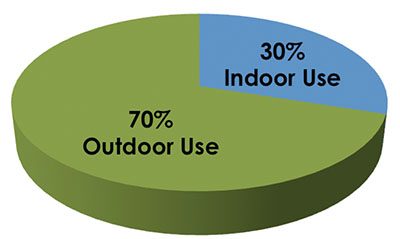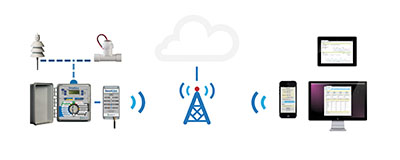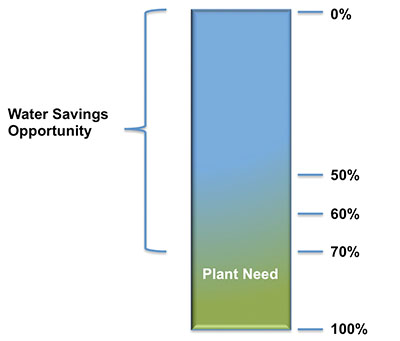How smart technology and services for landscape irrigation saves water and money.
In recent years, green products, practices and properties have become leading consumer and industry ideals. As alternative energies, pollution prevention and remediation, and nature preservation have taken the spotlight, water conservation has missed its due attention. Water use, however, has direct and immediate impacts upon consumers, property owners, and the environment. Recent developments in technology and services also make water use one of the easiest areas to address in the quest to go green and save money.
Overwatering: Prevalent and Pernicious
While water may seem like a cheap and renewable resource, quite the opposite is true. As water is pulled from underwater aquifers, glaciers and other non-renewable sources for human  Vint Lawsonconsumption, it cannot be replenished and often becomes polluted. By using more than 410 billion gallons of water per day — a 300% increase since 1950 — the United States has begun to drain the aquifers and dam the rivers that supply the water its citizens need for day-to-day life. This increasing water demand collides with climate change to create longer and more frequent droughts. The National Resources Defense Council predicts 70% of U.S. counties will face water shortages by 2050, and such shortages will plague at least 36 states by 2013.
Vint Lawsonconsumption, it cannot be replenished and often becomes polluted. By using more than 410 billion gallons of water per day — a 300% increase since 1950 — the United States has begun to drain the aquifers and dam the rivers that supply the water its citizens need for day-to-day life. This increasing water demand collides with climate change to create longer and more frequent droughts. The National Resources Defense Council predicts 70% of U.S. counties will face water shortages by 2050, and such shortages will plague at least 36 states by 2013.
For property owners, water shortages lead to higher water restrictions, usage fines and water rates that have climbed 25% since 2010. Wasting water, therefore, translates directly to increased and unnecessary operational costs. One of the primary causes of wasted water is landscape irrigation. Up to 70% of a commercial property’s water use goes to landscaping; however, the EPA estimates that the typical property overwaters its landscape by 50%. In a 1-acre property in the southwest, 50% overwatering equates to about 900,000 gallons of waste per year. Shortages and water lost to overwatering a commercial property thus carry a steep financial cost.
In addition to using precious financial and water resources, overwatering also causes costly damage to the property and surrounding environment. Excess water that cannot be absorbed washes away soil, cutting channels into the ground and damaging hardscape such as sidewalks and roads. Overwatering also sweeps away nutrients, fertilizers and lawn treatment chemicals off of the property, leaving it nutrient-poor and in need of additional treatment. These chemicals then flow into local streams and lakes where they cause algal growth and harms animals. Although plants need water, they can have too much of a good thing: overwatering is one of the leading causes of plant disease, impaired health and decreased productivity, while proper watering encourages deeper roots and healthier plants. Ironically, property owners then invest more and more money to make their plants healthier and soil more nutrient-rich, when simply watering at the right levels would decrease the cost of both water and landscape care.
Causes of Overwatering
 With the considerable costs of overwatering, one may wonder why the problem persists. Many factors contribute to improper watering, and most properties are plagued by more than one issue. At the root of most overwatering problems, however, is outdated and inadequate technology.
With the considerable costs of overwatering, one may wonder why the problem persists. Many factors contribute to improper watering, and most properties are plagued by more than one issue. At the root of most overwatering problems, however, is outdated and inadequate technology.
When introduced, clock-based timers and controls for irrigation systems significantly decreased labor costs. However, cutting out the human component in this way compromised the ability to adapt to changing temperature, precipitation, plant, soil and regulatory conditions. Clock-based timers set sprinklers to water at set times on set days, regardless of changing conditions. This rigid programming leads to the unfortunately ubiquitous sight of a sprinkler freely spraying during, or immediately after, a rain storm, wasting water and money simply because of its insensitive controller. Such daily programs frequently violate watering restrictions, incurring fines for property owners in violation.
Simple clock-based timers also cannot account for the myriad of factors that dictate proper watering. The best amount of water, method and schedule for delivery varies with soil type, plant type, slope and exposure. Not only does a property typically consist of many zones, each with different needs based on these factors, but changes in weather also alter each zone’s daily watering needs. Even expert human knowledge typically cannot integrate all of these factors to design the perfect watering system — and if it could, it would require painstaking care and intense time investment.
While many of today’s irrigation controllers can respond to changing weather conditions, most must be installed and monitored by trained professionals. In and of themselves, controllers are unable to respond to system malfunctions, power outages, time changes or other alterations in operating conditions. Instead, each of these malfunctions must be discovered, reported and solved on-site. At the El Segundo School District in California, for example, the landscape management company used to make at least four trips per week to each of the 26 school campuses in the district in order to maintain and reset the clock-based timers. Not only do simple timers thus have high labor and maintenance costs, the lack of instant monitoring and management means problems with the system are typically not discovered until precious time and money is lost to leaks, improper water or other system malfunctions.
 Lastly, overwatering frequently occurs due to outdated and malfunctioning irrigation systems. System breaks — whether merely a misaligned sprinkler head or a broken main line — only cost $25 to $500 to repair. If the breaks are not detected, however, they can cost a property manager up to $10,000 per month in water alone; property damage from the break would incur even more costs. Landscape maintenance contractors often cannot monitor systems closely enough to detect breaks quickly, nor do they see, pay for, or respond to the cost of the water wasted by breaks or inefficient watering.
Lastly, overwatering frequently occurs due to outdated and malfunctioning irrigation systems. System breaks — whether merely a misaligned sprinkler head or a broken main line — only cost $25 to $500 to repair. If the breaks are not detected, however, they can cost a property manager up to $10,000 per month in water alone; property damage from the break would incur even more costs. Landscape maintenance contractors often cannot monitor systems closely enough to detect breaks quickly, nor do they see, pay for, or respond to the cost of the water wasted by breaks or inefficient watering.
The key to giving properties the exact right amount of irrigation and eliminating water waste, therefore, lies in appropriate irrigation technology governed by updated controllers that plan watering schedules based on slope, plant type, soil type and water restrictions, while constantly adjusting for current weather conditions. Instant remote access to the controls and trained oversight are also necessary to monitor water use and immediately respond to system malfunctions.
Smart Controllers
With recent advances in technology, most overwatering problems can be solved by installing smart irrigation controllers. According to the Irrigation Association, “‘Smart’ irrigation controllers maximize outdoor water use efficiency by using climate and site, or soil moisture data as a basis for irrigation scheduling — maintaining, and in many cases enhancing, the health and beauty of the landscape.” These smart controls collect and utilize local data to adjust watering. They are available in three primary forms:
- Soil water sensors measure soil dampness at the site and accordingly adjust watering schedules. While soil sensors directly link watering to soil moisture, soil moisture is typically generalized across the whole property unless multiple sensors are used. Because the sensors automatically respond to soil dryness regardless of day or time, they can also violate watering restrictions.
- ET add-ons: “ET” stands for evapotranspiration, the rate at which plants lose water to transpiration and evaporation (Dukes et al. 2009). For a subscription fee, these add-ons to existing controllers calculate ET rates based on data decoded from local weather stations. While these controllers calculate real-time ET rates, they are not zone- or site-specific. As a result, sites are often underwatered by 25% to 40% and plants die, especially during hot summer months.
- Real-time ET-based controllers with site-specific weather stations provide the most accurate solution to irrigation efficiency. Miniature weather stations on the property collect rainfall, temperature, and other data to calculate ET at one or more locations on the property. These controls provide the best combination of site specificity and accuracy. They reduce water use by an average of 50%, and boast a 3- to 24-month payback period.
Smart controllers can only go so far in saving water, however; to get the most out of these controllers, constant monitoring is necessary. Some manufacturers have introduced subscription-based wireless technology that enables real-time control and management of the irrigation systems. A wireless air card attaches to the smart controller, allowing web-based access to the irrigation controller from any computer, tablet or smartphone. From there, the property manager can control the sprinkler system remotely, receiving alerts about outages, leaks, or other issues, and can instantly shut down the system or change the watering schedule, for example. Many systems also collect water use and savings data, so property owners can see how much water and money they are saving.
 For most technology, installation and maintenance by expert technicians enables good products to perform optimally — the same is true for irrigation systems and controllers. As the U.S. Environmental Protection Agency notes in its publication WaterSense at Work: Best Management Practices for Commercial and Institutional Facilities, “The key to saving irrigation water is to combine efficient irrigation practices with efficient technologies.” While smart controls can generate a 30% to 40% water savings, an additional 20% to 25% can be saved when properly trained technicians install, monitor and repair these irrigation systems and controls. Sustainability services provided by irrigation companies utilize data collected via the wireless connections for their highly trained technicians to regularly monitor the irrigation systems, recommend repairs and improvements to maximize water savings, and respond to system errors. This integrated approach applies the irrigation company’s specialized knowledge and expertise where it may be lacking in the local landscape contractor, and keeps contractors accountable to the maintenance and oversight they commit to.
For most technology, installation and maintenance by expert technicians enables good products to perform optimally — the same is true for irrigation systems and controllers. As the U.S. Environmental Protection Agency notes in its publication WaterSense at Work: Best Management Practices for Commercial and Institutional Facilities, “The key to saving irrigation water is to combine efficient irrigation practices with efficient technologies.” While smart controls can generate a 30% to 40% water savings, an additional 20% to 25% can be saved when properly trained technicians install, monitor and repair these irrigation systems and controls. Sustainability services provided by irrigation companies utilize data collected via the wireless connections for their highly trained technicians to regularly monitor the irrigation systems, recommend repairs and improvements to maximize water savings, and respond to system errors. This integrated approach applies the irrigation company’s specialized knowledge and expertise where it may be lacking in the local landscape contractor, and keeps contractors accountable to the maintenance and oversight they commit to.
Case Study
In 2006, a national retail bank pledged to decrease their water use by 20% over the subsequent 12 years as part of a larger sustainability initiative. As part of this pledge, they examined their landscape water use and conducted a pilot study in 2010 to test which irrigation systems and controllers from three leading manufacturers provided the best results. After a year of study, they found that ET-based smart controls with local weather stations and a wireless connectivity saved them $107,000 and 17.8 million gallons of water saved across 13 properties, with only 12 months until payback on their investment based on these savings. In 2011, a similar pilot project at six Florida sites in 2012 reduced landscape water use by approximately 75% at each site, resulting in a savings of 8.9 million gallons, or $67,000, and less than 3 months to payback on investment. The bank was so satisfied with the results that in 2012 and 2013, they chose to begin implementing this leading smart controller, wireless technology, and sustainability service system nationwide at over 150 properties. Thus far, they have saved over $1,040,000 per year, 221 million gallons of water per year, and a 0.7 year payback. With water savings ranging from 45% to 75% at each sites, and many locations saving over 1 million gallons per year, the bank plans to continuing implementing the sustainability services and smart technology at more and more sites.
Getting Smart About Water
As precious water resources dwindle, property managers have both an environmental and financial responsibility and incentive to reduce their landscape water use. Especially when used together, smart controllers, wireless technologies, and sustainability services by trained professionals dramatically decrease water use while increasing the beauty and health of the property and the surrounding environment. These technologies and services also have rapid payback and lead to significant financial savings that make them a logical choice for properties of all types.
— Bill Robinson is executive vice president of Weathermatic Sustainability Services; Vint Lawson is senior account executive of Weathermatic Sustainability Services, which designs, manufactures and distributes irrigation solutions, smart controllers and sustainability services.
